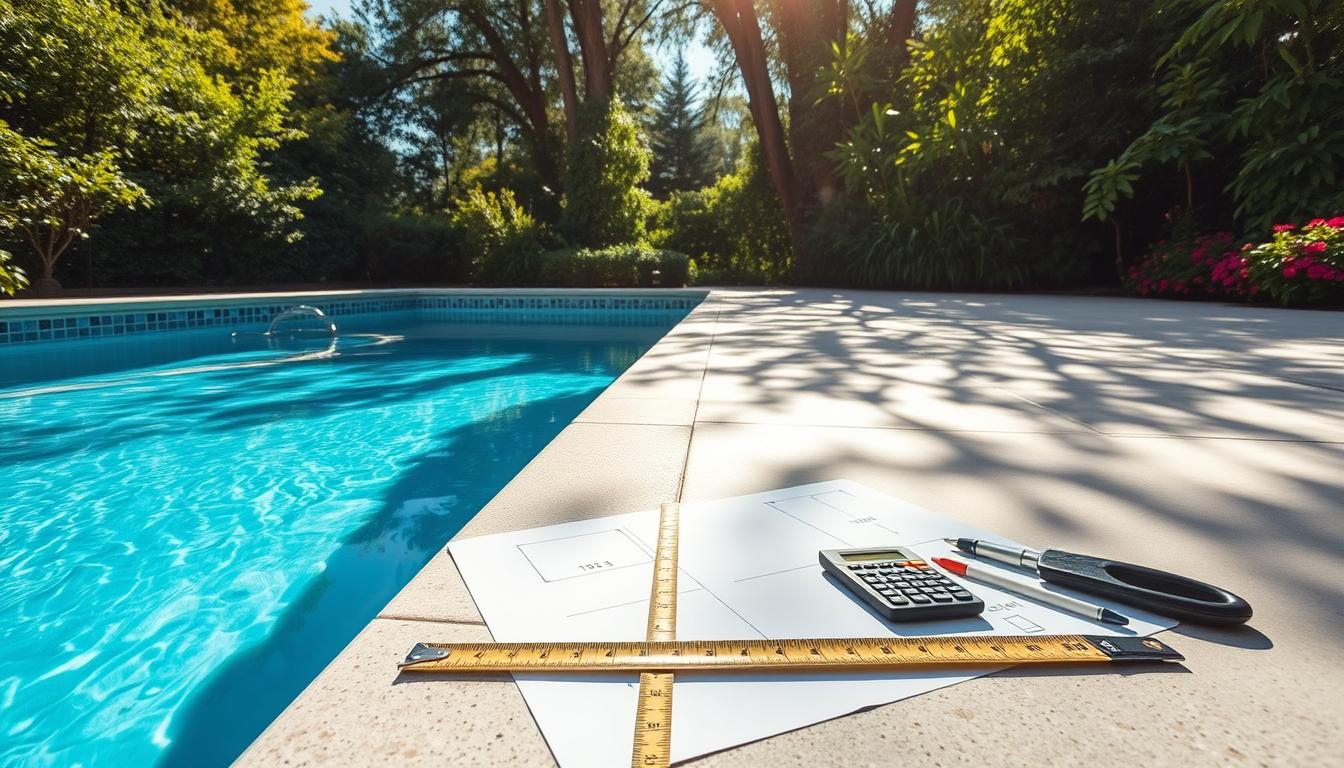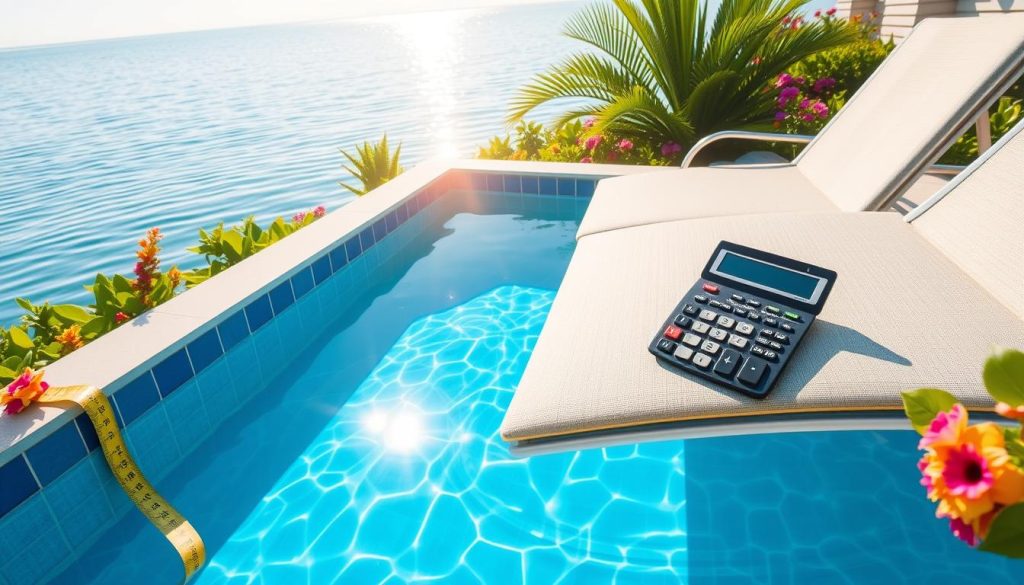
Measuring your pool’s square footage is vital for many reasons. It helps with renovations, maintenance costs, and understanding your pool’s size. You can easily figure out your pool’s area with the right tools and methods.
This guide will help you measure your pool’s square footage accurately. You’ll learn to use tape measures and pool deck calculators effectively. This knowledge can save you money on materials and maintenance.
Our step-by-step approach will make you a pro at pool measurements. You’ll gain confidence in assessing your pool’s size and making smart decisions. This guide works for both new and experienced pool owners.
Understanding the Basics of Pool Square Footage
Pool square footage is key for planning installations or renovations. It’s the area of a pool in square feet (ft²). This measurement helps estimate materials and optimize space.
Square footage is used in construction, real estate, and interior design. Knowing how to calculate it aids in better project planning.
Why Accurate Pool Measurements Matter
Precise pool measurements ensure fair pricing for purchases or renovations. They help make informed decisions about properties with pools.
Exact dimensions allow for selecting the right equipment size. This leads to better water quality and energy efficiency.
| Pool Size | Price Range | Capacity (People) |
|---|---|---|
| 12′ x 24′ | Under $50,000 | 8 |
| 15′ x 30′ | Under $75,000 | 12 |
| 16′ x 32′ | $100,000 and higher | 16 |
| 20′ x 40′ | $100,000 and higher | 20+ |
Different Pool Shapes and Their Impact on Square Footage
Pools come in various shapes, affecting total square footage and layout. Common shapes include rectangles, circles, and L-shapes.
For irregular pools, break them into smaller, simpler shapes for easier measuring. Understanding shapes helps plan outdoor space and integrate pools with landscapes.
Many homeowners regret not opting for a larger shallow end in their pools, as it provides more space for lounging and family activities.
Grasping pool square footage is crucial for installations or renovations. Accurate measurements help make informed decisions about outdoor spaces.
Understanding different shapes’ impact ensures the pool remains valuable and enjoyable. It helps optimize the space for years to come.
Essential Tools for Measuring Your Pool
Accurate pool measurements are vital for successful projects. A tape measure and pool deck calculator are key tools. They provide precise data for planning and material calculations.
Using a Tape Measure for Precise Measurements
A tape measure is essential for calculating pool square footage. It offers precise length and width measurements. Here are some tips for using a tape measure effectively:
- Always pull the tape tight and straight to avoid any slack or curves that could affect the accuracy of your measurements.
- If you’re measuring a large pool, ask a friend to hold one end of the tape measure while you hold the other end to ensure a stable and accurate measurement.
- Take note of any curves or angles in your pool’s design, as these can impact the overall square footage. Measure these areas separately and factor them into your calculations.
Utilizing a Pool Deck Calculator for Efficient Results
A pool deck calculator simplifies planning your outdoor space. It estimates deck square footage and material needs accurately. Input pool dimensions and desired deck size to use it.
The calculator provides total pool and patio areas. It also estimates required concrete amounts. This tool removes guesswork from your planning process.
| Pool Length (ft) | Pool Width (ft) | Deck Width (ft) | Total Pool Area (sq ft) | Total Deck Area (sq ft) | Concrete Needed (cu yd) |
|---|---|---|---|---|---|
| 20 | 10 | 4 | 200 | 448 | 4.1 |
| 30 | 15 | 6 | 450 | 1,116 | 10.3 |
| 40 | 20 | 8 | 800 | 2,112 | 19.6 |
A pool deck calculator quickly determines pool and deck dimensions. It provides accurate information for planning and budgeting. These tools ensure confident and precise pool measurements.
Step-by-Step Guide: How to Calculate Pool Square Footage
Knowing your pool’s square footage is vital for proper maintenance. It helps you use the right amount of chemicals and buy the correct pool cover. This guide will show you how to measure your pool and calculate its area.
Accurate measurements ensure you can estimate repair costs correctly. They also help you plan for renovations effectively. Let’s dive into the process of determining your pool’s shape and size.

Determining Your Pool’s Shape
First, identify your pool’s shape. Most pools are rectangular, circular, oval, or irregular. Each shape needs a different formula to calculate its area.
Knowing your pool’s shape is crucial for accurate measurements. It will guide you in choosing the right calculation method.
- Rectangular pools are the most common and easiest to measure, with straight sides and 90-degree angles.
- Circular pools have a consistent radius from the center point to any point on the pool’s edge.
- Oval pools feature a combination of straight sides and curved ends, resembling an elongated circle.
- Irregular pools have unique shapes that don’t fit into the above categories, often with curves, angles, or freeform designs.
Measuring the Length and Width of Your Pool
After determining the shape, measure your pool’s dimensions. For rectangular and oval pools, measure the length and width at the longest points.
If your pool has a consistent depth, measure from the water’s edge. For varying depths, measure from the pool’s upper edge for accuracy.
For circular pools, measure the diameter across the center. Divide this number by two to find the radius for area calculation.
Pro Tip: Use a long measuring tape or laser measurer for the most precise measurements. If your pool has a cover, measure the cover’s dimensions for a quick and easy estimate.
Calculating the Total Square Footage
Now that you have the measurements, use the right formula to calculate the area. The formula depends on your pool’s shape.
| Pool Shape | Formula |
|---|---|
| Rectangular | Length × Width |
| Circular | π × Radius² |
| Oval | π × (Radius 1 × Radius 2) |
| Irregular | Divide into smaller shapes, calculate each area, and add together |
For example, a 20-foot long by 10-foot wide rectangular pool would have an area of 200 square feet. Always double-check your calculations for accuracy.
When ordering materials or chemicals, add an extra 10% to your total. This accounts for waste and cuts during installation or use.
Using these steps and the right formula, you can find your pool’s square footage. Accurate measurements help keep your pool clean, safe, and enjoyable for swimming.
Accounting for Unique Pool Features and Irregular Shapes
Calculating pool square footage requires attention to unique features and irregular shapes. Custom elements like stairs and curved edges need extra care for accuracy. Measure each step’s length and width separately, then add them together.
For curved areas, break them into smaller, straight sections. Measure each part individually and add them up. This approach gives a close estimate of the curved space.
Pool pros use special tools for irregular shapes and features. Laser measures and flexible tapes help map complex designs. These tools ensure precise measurements for deck builders and material purchases.
Knowing your pool’s exact square footage is vital for construction and maintenance. This information helps plan the substructure and ongoing care effectively.
Many homeowners choose kidney-shaped or freeform designs for a natural look. These pools range from 378 to 933 square feet. Infinity pools typically cover 810 to 1,094 square feet.
Accurate square footage calculation is key to successful installation. It ensures an enjoyable swimming experience for years to come. Choose the shape and size that best fits your backyard and needs.







